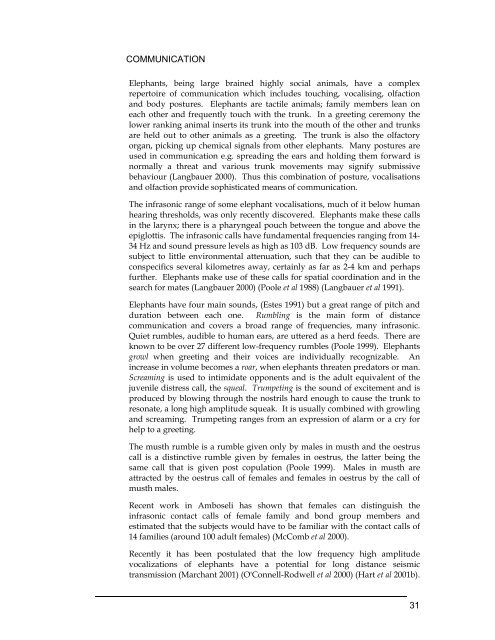Elephants Elephants - Wildpro - Twycross Zoo
Elephants Elephants - Wildpro - Twycross Zoo
Elephants Elephants - Wildpro - Twycross Zoo
Create successful ePaper yourself
Turn your PDF publications into a flip-book with our unique Google optimized e-Paper software.
COMMUNICATION<br />
<strong>Elephants</strong>, being large brained highly social animals, have a complex<br />
repertoire of communication which includes touching, vocalising, olfaction<br />
and body postures. <strong>Elephants</strong> are tactile animals; family members lean on<br />
each other and frequently touch with the trunk. In a greeting ceremony the<br />
lower ranking animal inserts its trunk into the mouth of the other and trunks<br />
are held out to other animals as a greeting. The trunk is also the olfactory<br />
organ, picking up chemical signals from other elephants. Many postures are<br />
used in communication e.g. spreading the ears and holding them forward is<br />
normally a threat and various trunk movements may signify submissive<br />
behaviour (Langbauer 2000). Thus this combination of posture, vocalisations<br />
and olfaction provide sophisticated means of communication.<br />
The infrasonic range of some elephant vocalisations, much of it below human<br />
hearing thresholds, was only recently discovered. <strong>Elephants</strong> make these calls<br />
in the larynx; there is a pharyngeal pouch between the tongue and above the<br />
epiglottis. The infrasonic calls have fundamental frequencies ranging from 14-<br />
34 Hz and sound pressure levels as high as 103 dB. Low frequency sounds are<br />
subject to little environmental attenuation, such that they can be audible to<br />
conspecifics several kilometres away, certainly as far as 2-4 km and perhaps<br />
further. <strong>Elephants</strong> make use of these calls for spatial coordination and in the<br />
search for mates (Langbauer 2000) (Poole et al 1988) (Langbauer et al 1991).<br />
<strong>Elephants</strong> have four main sounds, (Estes 1991) but a great range of pitch and<br />
duration between each one. Rumbling is the main form of distance<br />
communication and covers a broad range of frequencies, many infrasonic.<br />
Quiet rumbles, audible to human ears, are uttered as a herd feeds. There are<br />
known to be over 27 different low-frequency rumbles (Poole 1999). <strong>Elephants</strong><br />
growl when greeting and their voices are individually recognizable. An<br />
increase in volume becomes a roar, when elephants threaten predators or man.<br />
Screaming is used to intimidate opponents and is the adult equivalent of the<br />
juvenile distress call, the squeal. Trumpeting is the sound of excitement and is<br />
produced by blowing through the nostrils hard enough to cause the trunk to<br />
resonate, a long high amplitude squeak. It is usually combined with growling<br />
and screaming. Trumpeting ranges from an expression of alarm or a cry for<br />
help to a greeting.<br />
The musth rumble is a rumble given only by males in musth and the oestrus<br />
call is a distinctive rumble given by females in oestrus, the latter being the<br />
same call that is given post copulation (Poole 1999). Males in musth are<br />
attracted by the oestrus call of females and females in oestrus by the call of<br />
musth males.<br />
Recent work in Amboseli has shown that females can distinguish the<br />
infrasonic contact calls of female family and bond group members and<br />
estimated that the subjects would have to be familiar with the contact calls of<br />
14 families (around 100 adult females) (McComb et al 2000).<br />
Recently it has been postulated that the low frequency high amplitude<br />
vocalizations of elephants have a potential for long distance seismic<br />
transmission (Marchant 2001) (O'Connell-Rodwell et al 2000) (Hart et al 2001b).<br />
31

















